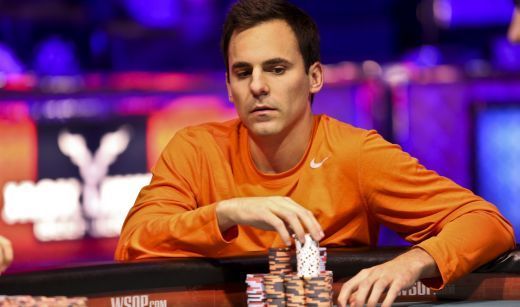
Poker pro Chris Klodnicki recently finished second in the $111,111 buy-in “One Drop High Roller” at the 2013 World Series of Poker, capturing a massive $2,985,495 in prize money. He played very well leading up to the final table and continued the trend by running a sneaky bluff past Antonio Esfandiari. However, there was also one huge hand at the final table that Klodnicki thinks he should have played differently.
Klodnicki took the time during one of his breaks in the $50,000 Poker Players Championship on Monday to talk about the two key hands from the biggest tournament of his life.
The First Hand
The very first hand Klodnicki played at the official final table was a big one.
The action started with him raising to 400,000 from the cutoff, and Martin Jacobson calling from the button. Klodnicki had the A J
J , while his opponent held the K
, while his opponent held the K Q
Q .
.
Both players had huge stacks and were undoubtedly looking to avoiding busting in eighth.
The flop fell 4 2
2 2
2 , and Klodnicki bet. Jacobson called.
, and Klodnicki bet. Jacobson called.
The turn brought the K , and Klodnicki decided to check with his back-doored flush draw.
, and Klodnicki decided to check with his back-doored flush draw.
Jacobson bet 800,000 with his top pair, and Klodnicki called.
The river brought the 7 , giving Klodnicki the nut flush. He checked.
, giving Klodnicki the nut flush. He checked.
Jacobson bet 2 million, and Klodnicki tanked before finally calling.
“A lot of people thought I should have check-raised there, but there’s really not many kings in his range,” Klodnicki said in defense of his decision. “So, there is nothing that I really think he is going to call a check-shove with, unless if he has me beat or floated with smaller hearts. But, I don’t think he is going to call a raise on the river with just kings-up, or call a raise if he is value-betting queens or jacks. I don’t think many fours are in his range, either.”
However, Klodnicki conceded: “I just didn’t think he would call with worse, but I talked with someone later and we figured out that check-min-raising would have been the optimal play. Obviously I would have hated if he shoved, and I would probably have to fold, but I think he might actually get curious with hands like kings-up or two 10s.”
The Second Hand
At about half-way through the entire final table, Esfandiari raised to 625,000 with the A 4
4 , and after the small blind folded, Klodnicki called from the big blind with the J
, and after the small blind folded, Klodnicki called from the big blind with the J 8
8 .
.
The flop fell A 9
9 6
6 , and action went check-check.
, and action went check-check.
The 3 on the turn prompted another check from Klodnicki.
on the turn prompted another check from Klodnicki.
Esfandiari bet 550,000, which Klodnicki check-raised to 1.5 million. Esfandiari called with his pair of aces, while Klodnicki needed to catch a card to make a hand.
The river was the 10 , and Klodnicki bet 3.3 million, with complete air, into a pot of 4.6 million.
, and Klodnicki bet 3.3 million, with complete air, into a pot of 4.6 million.
Antonio went into the tank for what seemed like forever, pulling out every trick in the book to try and get a read off of Klodnicki. Klodnicki gave him nothing.
Esfandiari eventually gave up trying to obtain more information and made the fold.
After the hand, Esfandiari was down to 13.65 million, while Klodnicki jumped to 14.35 million. The pot sent the defending champion into free-fall, and he eventually was eliminated in fourth.
Klodnicki explained the play by saying that a weak-ace was “at the top of [Esfandiari’s] range.”
“He could have had absolutely nothing on the turn…once he called the turn I realized he had something…but he’s good enough to check back a flop there with nothing to represent a weak ace. After he called the turn I was pretty sure he had some kind of pair. It was a good river for me because I could represent 8-7, and I figured if I bet there I get him to fold often enough.”
Despite the strong line Klodnicki decided to take, the bluff apparently worked for one very simple reason. Klodnicki explained:
“He told me that I looked very comfortable and that’s why he folded, but I wasn’t (laughing). I was trying to relax and look at the dealer, gave her a little smile to keep myself relaxed.”
“I was hoping someone would call the clock, because I didn’t want to do it myself,” he added.
